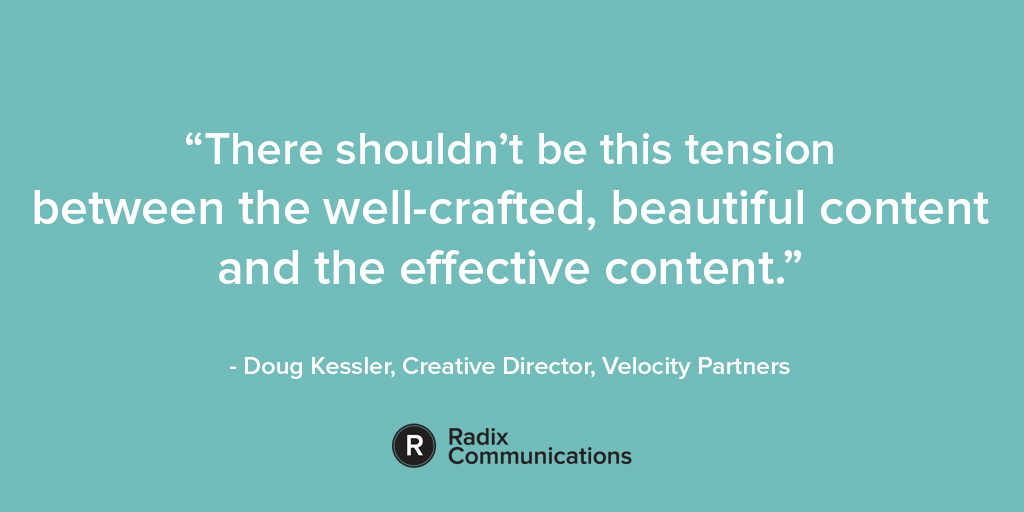If you’ve read our Barriers to Great B2B Content 2020 report, you know the results are pretty bleak. Of the 105 B2B marketers we interviewed, 68% said they’re not proud of even half their own content.
You might even be one of that number. And if so, it’s probably because where you work doesn’t work for you. Whether it’s because of internal politics, limited resources or interfering stakeholders, our survey showed that lots of marketers just don’t have the right environment to thrive.
And while many of these obstacles may be out of your control, every self-appointed marketing expert will still judge the ‘unoriginal’ work you produce as a result.
We talked to Maureen Blandford, VP of Marketing at Community Brands, about this particular frustration and she gave us a great response: “A lot of the time we have no choice, unless you happen to be in a lucky fairy land.” (Feel free to yell that whenever the mood takes you.)
But don’t give up hope. Your perfect B2B workplace – where you really can be proud of the content you publish – could be out there.
So, what would it look like and how can you identify it? We’ve spoken to Maureen and examined the statistics. Here’s what to look for.
Does company size matter?
Unsurprisingly, our survey revealed that across small, mid-sized and enterprise-scale firms, marketers have different ideas about what makes content great. Similarly, we found that different sized business find some obstacles more challenging than others:
But which will enable you to create your best content? Well, that depends what problems you find least intrusive, and what aspects of B2B content you value most.
We’ve taken a deep dive into the survey results shown above. These figures, taken directly from our global survey of B2B marketers, suggest how the benefits and obstacles of working in an enterprise, mid-sized organisation or a smaller firm could vary.
Enterprise:
Benefits
- Least likely to struggle with workload or budget
- Best chance of being proud of your content’s design, humour or emotional impact
- Close correlation between perceived quality and business results
Obstacles
- Brand, legal or policy issues could be an issue
- Direct contact with your customers is likely to be very limited
- Lowest chance of creating content that reflects customer priorities
Mid-size business:
Benefits
- Highest likelihood of reflecting customer priorities
- Slightly better chance of avoiding stakeholder interference
- Fewest problems with brand and legal restrictions
Obstacles
- Workload and budget issues are almost inevitable
- Least chance of using humour, originality or emotion
- Most likely to experience departmental friction
Small business:
Benefits
- Easy contact with customers
- Coordinating with other departments is less of a challenge
- Best chance of writing copy you’re proud of
Obstacles
- Constantly changing priorities likely to be a big issue
- Micromanagement from senior leadership is likely
- Smallest correlation between satisfaction and business results
When we asked Maureen, she said:
“I work in a sizable company as head of marketing for one of the divisions, and I’ve also worked for small tech companies and start-ups. And while size doesn’t really matter, a HUGE difference – in our quality of work and its results – is seen when bosses and executive teams are switched on and work collaboratively.”
So if you have an excellent leadership team, you’re more likely to create effective content you’re happy with – regardless of where you work. But what does that team look like? Well…
“Results follow good leadership”
When Totaljobs surveyed 2000 UK employees, they found one in two people had left a job because of bad management. And HR tech firm AdviserPlus found that in at least 70% of cases, management coaching resulted in better employee performance.
So the chances are, you’ve had at least one boss with questionable leadership skills.
And whether your boss was (or is) completely incompetent, or just a bit of a micromanager, poor leaders can prevent you from creating your best copy – or stop it being released.
We asked Maureen about great leadership in a B2B working environment – and how it can enable you to write copy you’re proud of. She said:
“There’s a whole bunch of stuff that goes into making content, that the market doesn’t acknowledge. Talent, passion and will are maybe 10% of it. Do you have a supportive team? Are sales co-operative? What about the leadership team? What kind of budget and tools do you have? How many micromanagers are there?
“I can tell you about my boss here, and my previous boss in Amsterdam, who runs a smaller technology company. Both of them had my back, completely supported me, and bought in to transformation.
“And the experiences I’ve had is exactly what Harvard Business School would say. The results are much stronger when leaders actually know how to lead, as opposed to leaders who are micromanaging jerks. Results follow good leadership.”
Toxic workplaces: “just get out”
You’ll find a B2B marketing workplace is always challenging – as our survey results made clear. With so many different departments and functional areas, everyone has their own goals and priorities. And earning their respect is no easy job – you’ll need to juggle a LOT of opinions.
And even though a challenging workplace is normal, it can still prevent you from producing your best work. 86% of our respondents say a problem with departmental co-operation gets in the way of their content.
We asked Maureen how she navigates this obstacle:
“I treat internal stakeholders like customers and prospects. I anticipate their objections, and what their values are. I’m never going to pitch our Head of Sales on some fancy-schmancy thing I want to do, or talk about colours. I’ll ask about her conversion rates, and where she wants to do better. Then I’ll frame projects to her business objectives.
“When I’m mentoring colleagues, I tell them we’re planting seeds. The first or second seed you plant may not grow or sprout ideas in their minds, but after a couple they start to understand your perspective.”
But a challenging culture is very different from a toxic one. So, how can you clearly define the two? Maureen draws a clear line between them:
“In most cultures, it’s challenging to work with colleagues in other functional areas. I don’t think I can code better than the software developers or do F&I better than the CFO; that’s not a thing. But of course everyone thinks they can do marketing.
“But a toxic culture is to do with the CEO; are they encouraging lying, cheating, stealing, hustling or hacking? People should be respectful but challenging, not demeaning and arrogant. If it’s a demeaning culture, that’s a toxic culture. And you’re not going to be able to change that, so just get out.”
And if you’re really, really determined to find the perfect workplace…
…You might need to commute a little further.
The statistics show that if you were to work in North America, you’re more likely to create content you’re proud of. Our survey found 39% of North Americans are happy with most of their work – a big jump from the 12.87% of European respondents.
It seems strange, we’ll give you that. But the figures above suggest some possible reasons. Only 30% of North American marketers find workload a big problem, compared to 50% of Europeans.
Meanwhile, North American marketers are least likely to agree with statement: “There’s always a trade-off between creating enough content, and keeping quality high”, while the European marketers we spoke to agreed 100%.
Of course, you’ll find plenty of job opportunities closer to home. We’re just saying – it’s an option.
How do you spot your ideal workplace IRL?
By now, you (hopefully) have a better image of a workplace that will enable you to create the content you’re proud of.
But when faced with a real-life opportunity, you might not have the transparency you need to know it’s right for you. Even Glassdoor can’t always help – despite having 67 million visits a month.
And truthfully, you’re going to have to gamble a bit. As Maureen says:
“For the most part, and this is not just for marketers, it is really hard to understand the culture until you get there. And it’s important not to feel ashamed about that – you did your best.
“But one way around that is if you actually know people at a company. If you’re being hired and you know someone, they can give you the straight scoop.”
So, use this guide to know exactly what you’re looking for. Then tailor the search to your specific preferences and find someone on the inside to get a clear picture. And when you get there? That’s when the real work begins.



